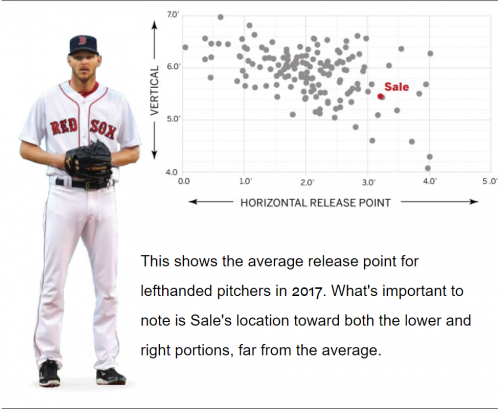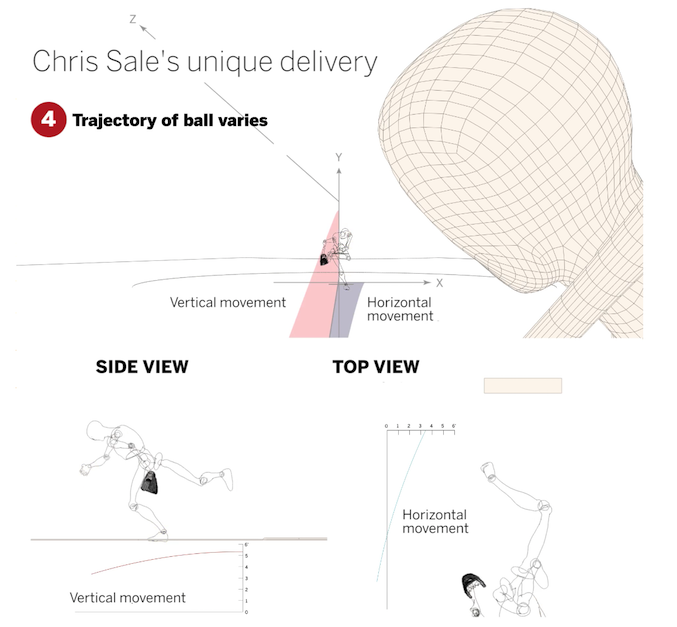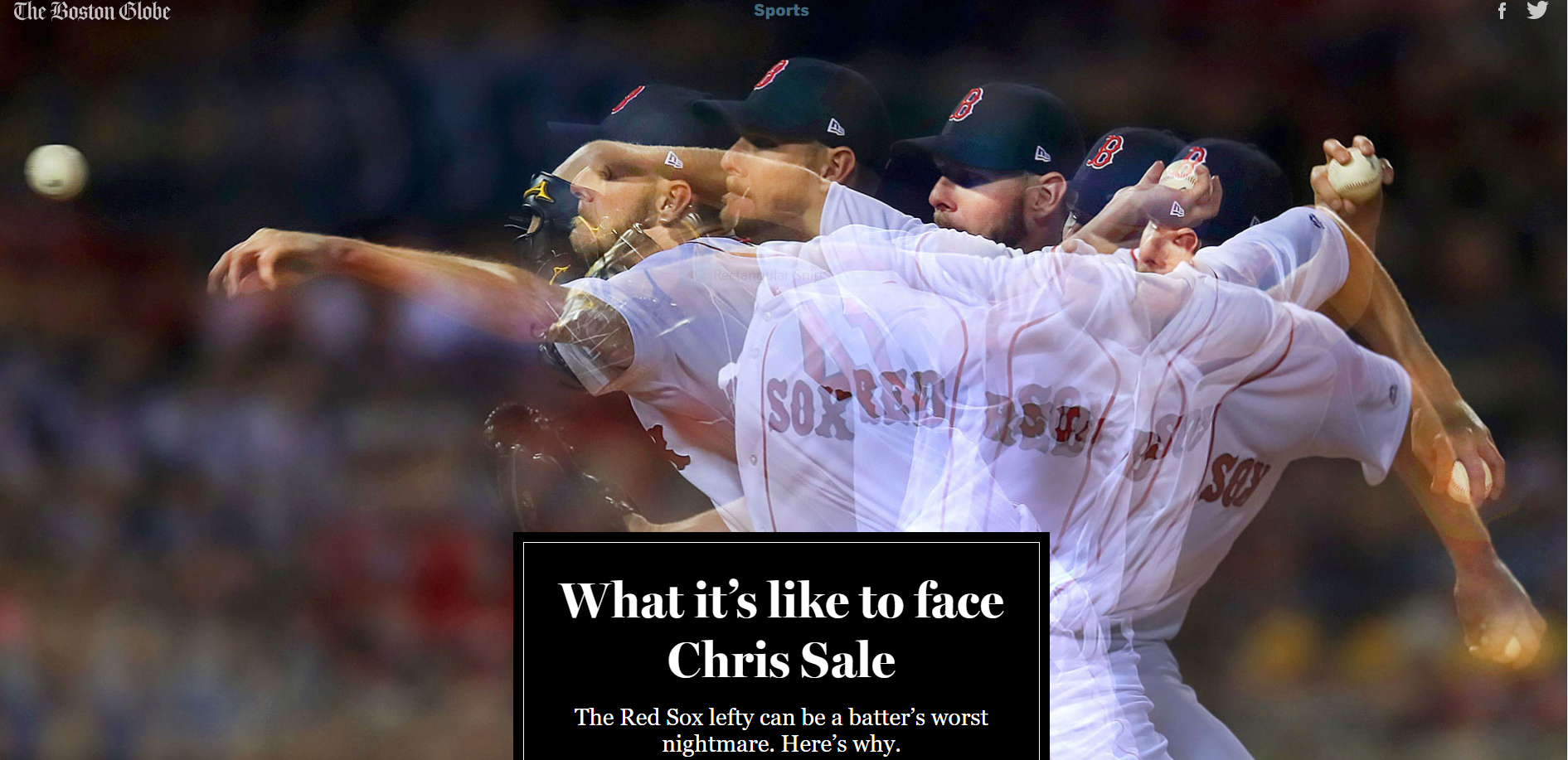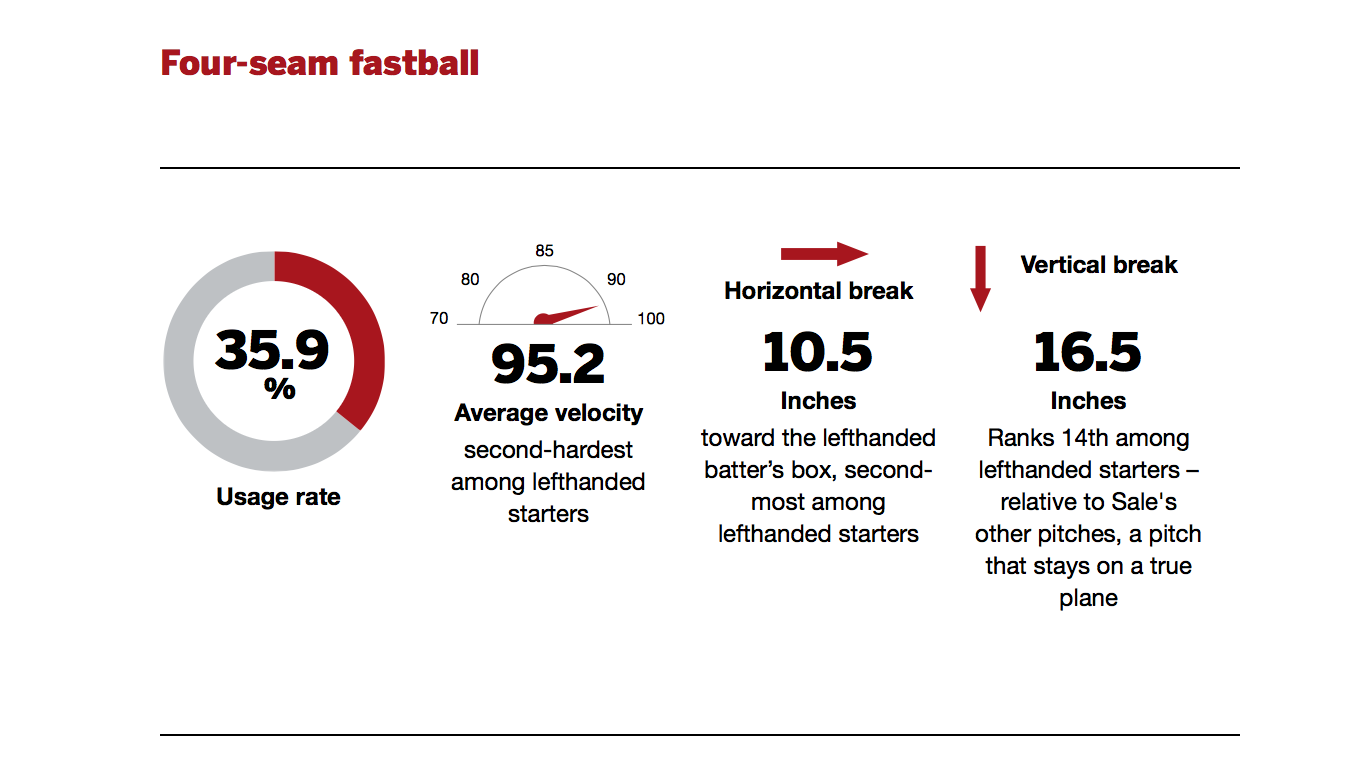How The Boston Globe brought Red Sox pitcher Chris Sale’s unique delivery to life
The Red Sox’s acquisition of pitcher Chris Sale in December has proved fruitful: The lefty ace has had, by almost any measure, the most dominant season by a Sox starting pitcher since Pedro Martinez regularly took the mound at Boston’s Fenway Park. Sale’s dominance, and the unusual style he uses to fuel it, provides a distinct challenge for the journalists who cover him: How do you bring that style to life in a way that transcends the traditional written story?
The result, for The Boston Globe, was “What it’s like to face Chris Sale,” a multimedia project leveraging written reporting and multimedia tools to answer that nagging question: Why is this guy so good? The final project, which took just under three months to compile, was published on July 10, one day before Sale started in the All-Star Game for the American League. The digital story included the exasperated reactions of hitters who have had the misfortune of facing him, animated models of his delivery, a graphic analysis of his release point and additional visuals breaking down his arsenal.
Storybench spoke with Michael Workman, a news designer at the Globe, and Tonia Cowan, deputy design director at the paper, about how they brought Chris Sale’s delivery to life.
Disclosure: The author is a Northeastern student who works on The Boston Globe’s metro desk. He has never worked with the journalists interviewed in this article. He admits to being a diehard Red Sox fan.
How did this project come to be, was it born out of a traditional written story or was the idea to incorporate multimedia from the get-go?
Michael Workman: It was multimedia from get-go. It was actually an idea that came from the writer, Alex Speier. He sort of had this idea that he wanted to do this, but definitely wanted to do it in a digital-first way, and wanted to use all of the tools that we have to do that. So he brought the idea to us, in the sports department, and we all sat down from the beginning and really talked about what the structure was going to be and how to tell the story, and really tried to think about, “What is the optimal way to tell this story online?” He was great from the beginning about being committed to that idea and embracing it, and helping us in terms of getting the data we needed to tell the story.
How did you decide to tell the story the way you did?
Workman: He had some points that he knew he wanted to illustrate in terms of the question, “What makes Chris Sale so difficult to hit.” He had already gathered some info and had some different answers to that question, and knew that a lot of them were data-related. So we started with an outline, just sketching out the points he wanted to make, and how were we going to tell them in this story. So it was me and Tonia Cowan, and Alex, we just sat in room and sketched on whiteboard, here’s what we want to do, here’s where we want to do it, just trying to get that organization.
Tonia Cowan: There were one or two meetings before I got involved, but the first meeting I was in was crucial. We used the wall of the meeting room to spec out the story and talk with the writer. The writer worked with us and talked about the content and broke it into chunks of reporting so that we could visualize it. The data was the minutia of each of Chris Sale’s pitches on an X, Y, and Z axis, so we knew how fast it’s traveling, how high off the ground, and the horizontal displacement. The data guy had already provided some charting material on his release point because his release point is key in describing Sale’s pitches. We were back at the wall sketching, we know where his release point was in comparison to other pitchers, so it was literally drawing a fake chart with the dots. So we discussed how to make it comprehensible to people, so I drew a figure just a rough image of pitcher in there, and we discussed it as, OK, it will mean something if it has a figure for scale. And then we went to the photo people, we took cellphone shots of wall, we needed a specific image to make this work, and measured it against his height and made it statistically sound. So that was one way the planning and the execution came together.

The most striking elements of the project to me were the visualizations, like the three different views of his delivery. Can you describe the process behind those elements?
Cowan: I work in a couple of different programs. I tried initially to set up figure and literally animate the mechanics of his pitch. So we went to Fenway and took cellphone video of him warming up from a couple different angles. My initial thought was to do it moving a figure that had the same proportions, in time, in one of my animation programs. That didn’t work. That was in LightWave, which was too complicated a program. I moved backward to an easier interface, a program called Poser. The upside of Poser is that I could move the figure more easily. The downside of Poser is I couldn’t put the ball movement in easily. So I took, frame by frame, every single movement Chris Sale did in the videos we took, viewing them in slow motion, I just moved the arms in the Poser figure to match [his body]. For the ball, I did three charts, three lines, charting it in space, and then put those three together, like literally old school charting, and then put them into Poser program as a template, so it’d be like looking at the camera from the side, from above, from the catcher’s point of view. Just literally moved the ball in the right space, so for example I did the horizontal displacement by looking at the top-view camera. In doing that, I had opportunity to look at this action from every angle. That’s why there are three of them in there, that wasn’t our initial intent. It suddenly struck me that I was having trouble understanding it with just one point of view, so the viewer might also have some fun in seeing it from the other camera angles at the same time.

How helpful was it to watch Sale warm up at Fenway?
Workman: Again, those were things that had been pointed out by Alex to us, in terms of, “This is what coaches and other players are telling me that are distinctive or unusual.” The key for us was being able to go and observe him and take some basic video for our reference.
Cowan: I didn’t initially intend to go along, but when I realized we could see him warm up I had already hit this question of how to move the figure, and it just suddenly seemed so much more direct and straightforward to literally go watch him than to sort through MLB footage. Initially I thought I was going to try super hard to shoot from catcher’s point of view. But the bullpen was really well situated to shoot him from different angles. In terms of what I was looking for, the pitch mechanics, I looked through all of the cell phone video footage we took, and was just able to see him from every point of view. I literally knew where his hands were at every juncture. It was completely wonderful and necessary for me. First-hand reporting, there’s nothing like that.
How did traditional reporting inspire the newer digital tools used in the project?
Workman: It’s absolutely crucial. Alex, in terms of being attuned to what our needs are and how we can tell this story online, was great in terms of getting us information. We as graphic artists and designers certainly have insight in terms of watching [Sale] on TV, but obviously the people who play the game and the people who coach the game understand this better than we ever will. Alex’s role was to talk to coaches, talk to opposing hitters, talk to other pitchers, and I know he spent quite some time interviewing a lot of people, a lot of which didn’t make it into the piece, but just really trying to drill down and understand what makes Chris Sale great. Without that, we don’t have an interactive. He also worked with a couple different statistical groups in terms of getting the data on the release point and providing it to us. In terms of his reporting, he might’ve heard people are saying, “Chris Sale has a really distinct release point,” but then to go look at the data and say, “Oh yeah, it really is distinct.” That really made the piece.
Cowan: That was the core of what made this possible. Alex is an extremely knowledgeable reporter. He has that thing that many reporters have, where if you just sit down at a table and talk to them about what’s so interesting about their story, it comes alive in that second. It’s almost like an elevator pitch. When they explain what it is that’s interesting, that articulation gives you basically everything you need to go out and find what it is you need to show.
Stories obviously evolve as you work on them. How did this one deviate from the original plan? Were there any concrete plans or intentions that didn’t pan out?
Workman: We had a couple different things we were talking about and thinking about. I think there’s always places you can take this to that would go even further. At one point we were talking more about getting into the batter’s vision and understanding how a batter sees a pitch and understanding more of that aspect. That ended up feeling like it was taking us a little further afield from focusing on Chris Sale, specifically. Major League Baseball does put some limits on how much video you could use. Certainly if we had unlimited use of video from games you might think about it a little bit differently. But I think what we wound up with was really close to what we sketched out and what we talked about.
Are you a baseball or Red Sox fan? Did that help the process?
Workman: I’m a baseball fan. I think so. I really want to emphasize that in terms of development of this, there was real group dynamic to it. You had Matt Pepin, who is one of most knowledgeable sports editors around, he’s been a digital guy in sports for forever. He was crucial to this, and Alex. All three of us have a passion for sports and for baseball, so yes I think that helped a lot. I think it’s also good to have people in the process who aren’t baseball fans, it’s good to have a mix. For me it was interesting because a lot of the concepts we brought up were things I had wondered about, and it was exciting to see how the data backed up or didn’t back up those assumptions.
Cowan: I am baseball fan, and I have really enjoyed going to see the Red Sox. I have a soft spot for – should I even say this? – for the Yankees, because it’s my son’s favorite team. We started going to games when my sons were three. So I have connection to my toddler son’s favorite team, but I really appreciate the Red Sox.
Any indication Chris Sale has seen the story?
Workman: I don’t know the answer to that. That was another challenge, because Sale is not really known as one of the more talkative Red Sox. I think he talks after his starts and that’s about it. Although I think Alex got him a little bit in spring training. So no, I don’t know, that’s a good question.
What’s your advice to journalism students looking to embark on similar projects?
Workman: I think collaboration is key, not necessarily trying to do it all on your own. Finding other people to work with that have a different expertise and different skills than you do, that group dynamic can be really useful. Once you have that group together, making sure that group understands, and is able to agree, on what the structure will be, finding a whiteboard or even piece of paper or whatever. It might seem a little counter intuitive, you know, “I’m going to do this great thing for online but first I’m going to write it out on paper,” that might seem a little old-school or primitive, but what it allows you to do is to get a good consensus together and figure out where you’re going. Because once you get into making these things and actually building them, there’s a lot of effort and a lot of time involved, and you need to make sure as best you can before you invest that time into it, that you know where you’re going. I think that’s something we’ve really emphasized here.
Cowan: Having that initial conversation where you — for me, having a pen or a marker and something to scribble on, and having the writer’s full attention, is even more important than any of the software down the line. Once you actually articulate the story, then the rest of it falls from there.
- How The Boston Globe brought Red Sox pitcher Chris Sale’s unique delivery to life - September 28, 2017






